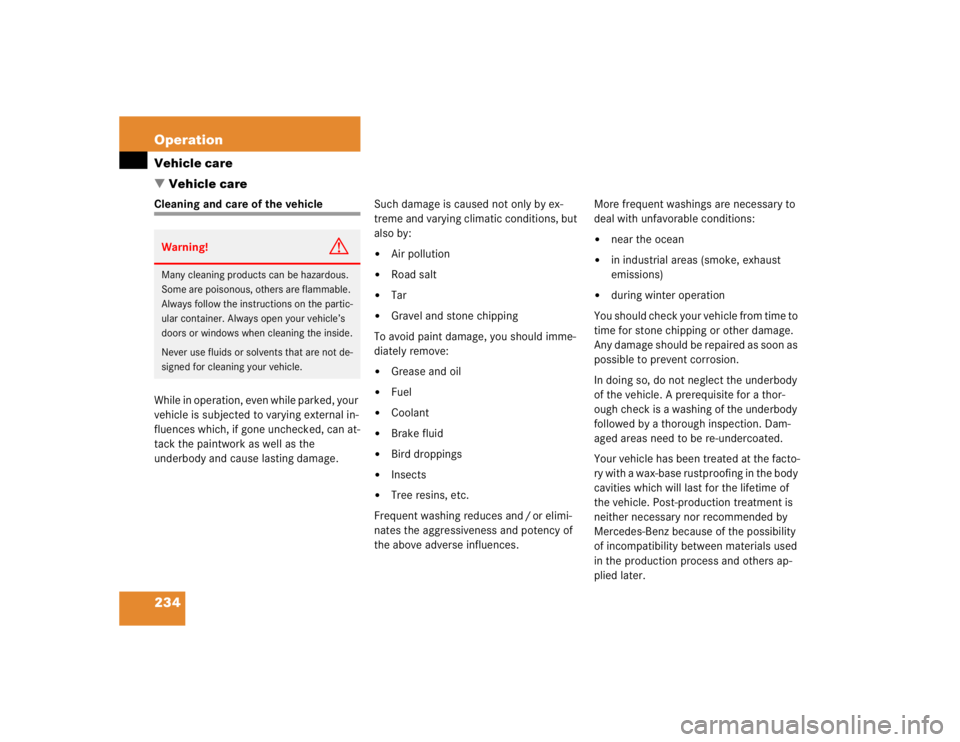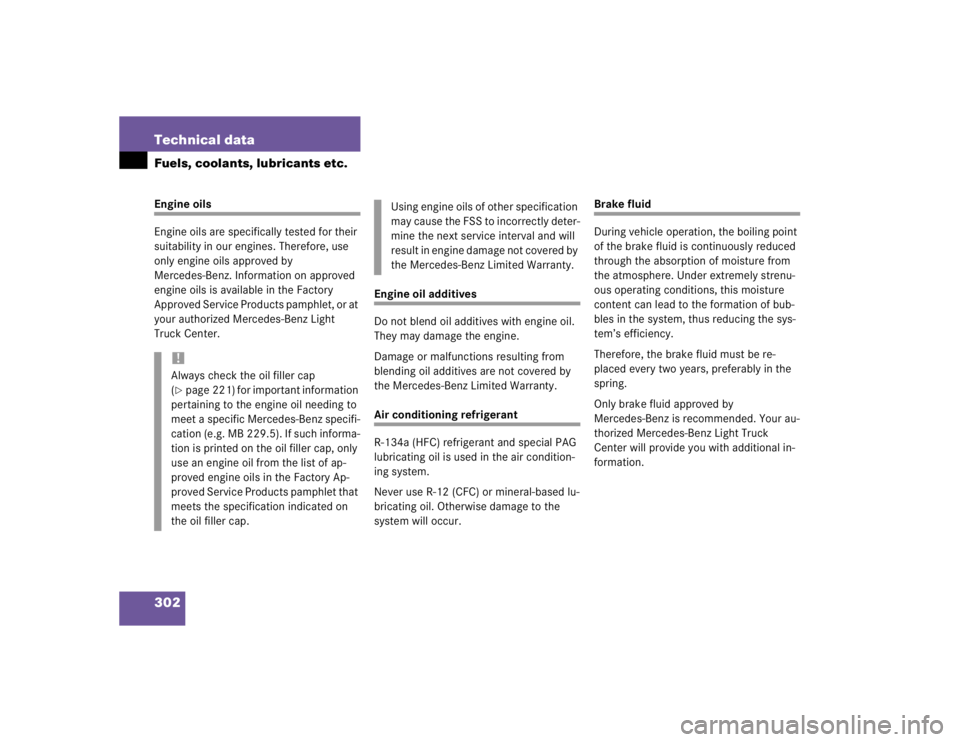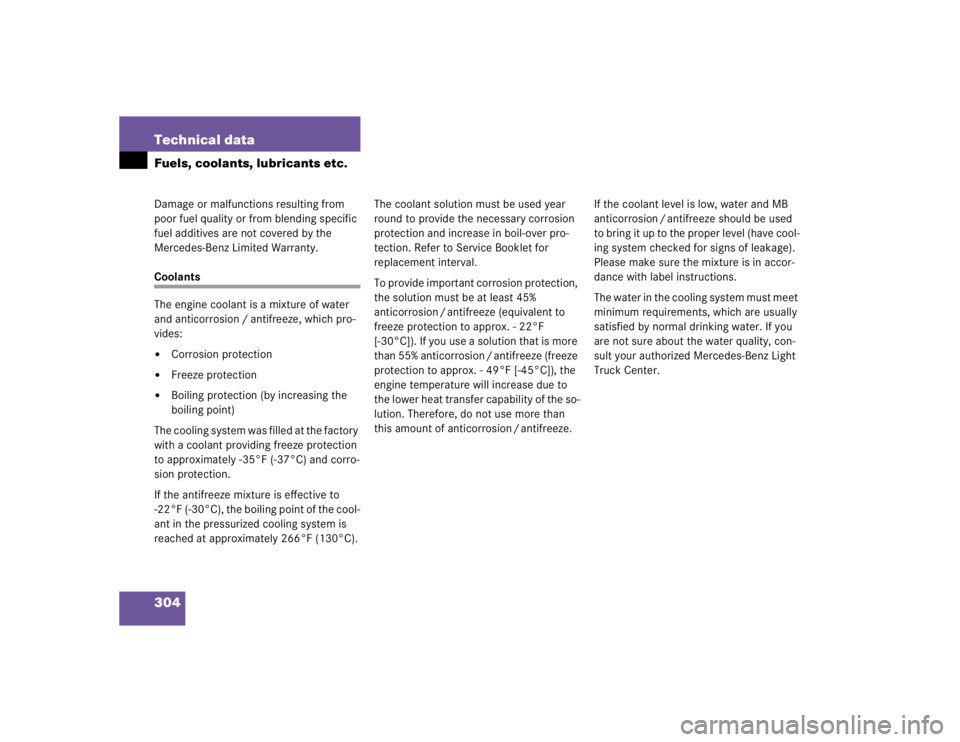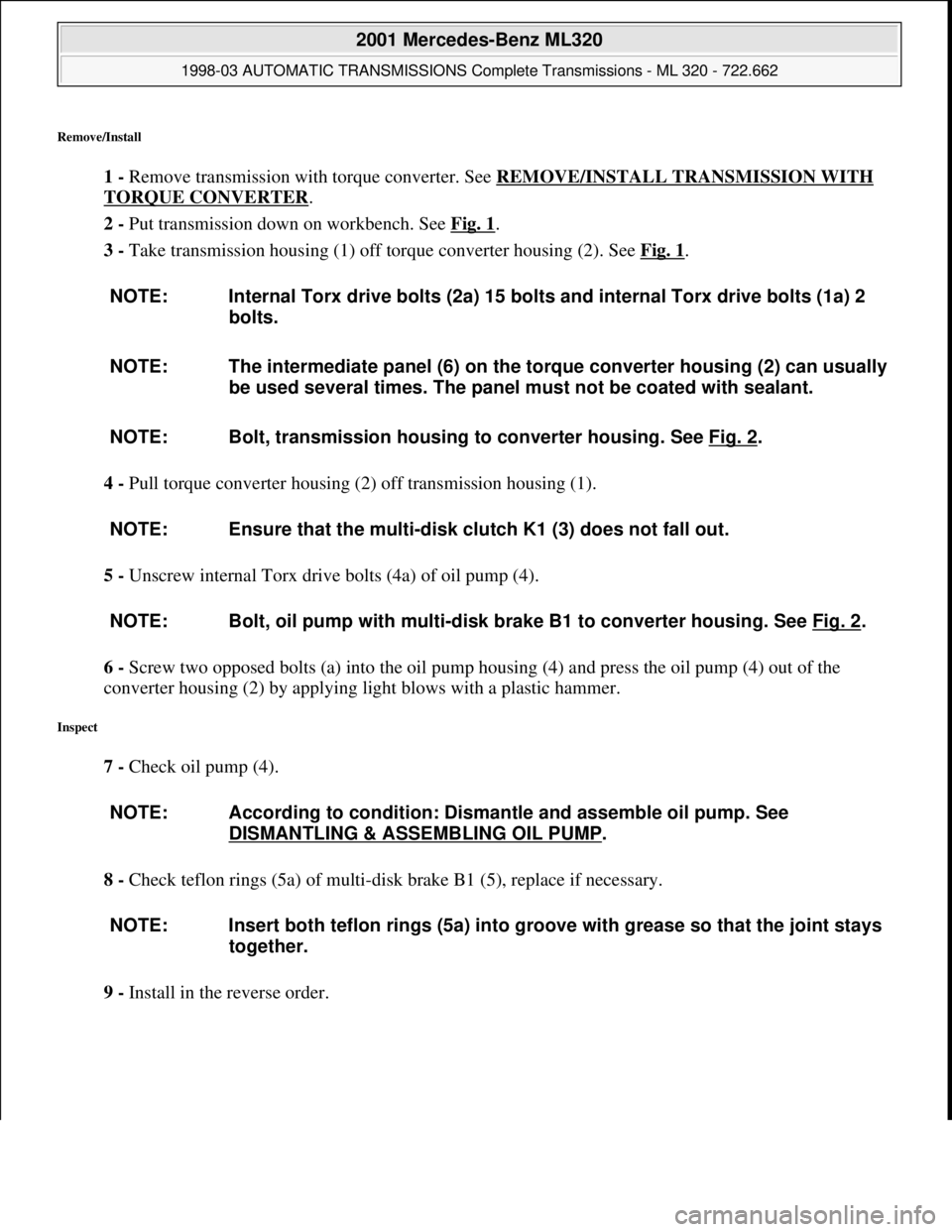Page 1038 of 4133

234 OperationVehicle care
�Vehicle careCleaning and care of the vehicle
While in operation, even while parked, your
vehicle is subjected to varying external in-
fluences which, if gone unchecked, can at-
tack the paintwork as well as the
underbody and cause lasting damage.Such damage is caused not only by ex-
treme and varying climatic conditions, but
also by:
�
Air pollution
�
Road salt
�
Tar
�
Gravel and stone chipping
To avoid paint damage, you should imme-
diately remove:
�
Grease and oil
�
Fuel
�
Coolant
�
Brake fluid
�
Bird droppings
�
Insects
�
Tree resins, etc.
Frequent washing reduces and / or elimi-
nates the aggressiveness and potency of
the above adverse influences.More frequent washings are necessary to
deal with unfavorable conditions:
�
near the ocean
�
in industrial areas (smoke, exhaust
emissions)
�
during winter operation
You should check your vehicle from time to
time for stone chipping or other damage.
A n y d a m a g e s h o u l d b e r e p a i r e d a s s o o n a s
possible to prevent corrosion.
In doing so, do not neglect the underbody
of the vehicle. A prerequisite for a thor-
ough check is a washing of the underbody
followed by a thorough inspection. Dam-
aged areas need to be re-undercoated.
Your vehicle has been treated at the facto-
ry with a wax-base rustproofing in the body
cavities which will last for the lifetime of
the vehicle. Post-production treatment is
neither necessary nor recommended by
Mercedes-Benz because of the possibility
of incompatibility between materials used
in the production process and others ap-
plied later.
Warning!
G
Many cleaning products can be hazardous.
Some are poisonous, others are flammable.
Always follow the instructions on the partic-
ular container. Always open your vehicle’s
doors or windows when cleaning the inside.
Never use fluids or solvents that are not de-
signed for cleaning your vehicle.
Page 1106 of 4133

302 Technical dataFuels, coolants, lubricants etc.Engine oils
Engine oils are specifically tested for their
suitability in our engines. Therefore, use
only engine oils approved by
Mercedes-Benz. Information on approved
engine oils is available in the Factory
Approved Service Products pamphlet, or at
your authorized Mercedes-Benz Light
Truck Center.
Engine oil additives
Do not blend oil additives with engine oil.
They may damage the engine.
Damage or malfunctions resulting from
blending oil additives are not covered by
the Mercedes-Benz Limited Warranty.Air conditioning refrigerant
R-134a (HFC) refrigerant and special PAG
lubricating oil is used in the air condition-
ing system.
Never use R-12 (CFC) or mineral-based lu-
bricating oil. Otherwise damage to the
system will occur.
Brake fluid
During vehicle operation, the boiling point
of the brake fluid is continuously reduced
through the absorption of moisture from
the atmosphere. Under extremely strenu-
ous operating conditions, this moisture
content can lead to the formation of bub-
bles in the system, thus reducing the sys-
tem’s efficiency.
Therefore, the brake fluid must be re-
placed every two years, preferably in the
spring.
Only brake fluid approved by
Mercedes-Benz is recommended. Your au-
thorized Mercedes-Benz Light Truck
Center will provide you with additional in-
formation.
!Always check the oil filler cap
(�page 221) for important information
pertaining to the engine oil needing to
meet a specific Mercedes-Benz specifi-
cation (e.g. MB 229.5). If such informa-
tion is printed on the oil filler cap, only
use an engine oil from the list of ap-
proved engine oils in the Factory Ap-
proved Service Products pamphlet that
meets the specification indicated on
the oil filler cap.
Using engine oils of other specification
may cause the FSS to incorrectly deter-
mine the next service interval and will
result in engine damage not covered by
the Mercedes-Benz Limited Warranty.
Page 1108 of 4133

304 Technical dataFuels, coolants, lubricants etc.Damage or malfunctions resulting from
poor fuel quality or from blending specific
fuel additives are not covered by the
Mercedes-Benz Limited Warranty.Coolants
The engine coolant is a mixture of water
and anticorrosion / antifreeze, which pro-
vides:�
Corrosion protection
�
Freeze protection
�
Boiling protection (by increasing the
boiling point)
The cooling system was filled at the factory
with a coolant providing freeze protection
to approximately -35°F (-37°C) and corro-
sion protection.
If the antifreeze mixture is effective to
-22°F (-30°C), the boiling point of the cool-
ant in the pressurized cooling system is
reached at approximately 266°F (130°C).The coolant solution must be used year
round to provide the necessary corrosion
protection and increase in boil-over pro-
tection. Refer to Service Booklet for
replacement interval.
To provide important corrosion protection,
the solution must be at least 45%
anticorrosion / antifreeze (equivalent to
freeze protection to approx. - 22°F
[-30°C]). If you use a solution that is more
than 55% anticorrosion / antifreeze (freeze
protection to approx. - 49°F [-45°C]), the
engine temperature will increase due to
the lower heat transfer capability of the so-
lution. Therefore, do not use more than
this amount of anticorrosion / antifreeze.If the coolant level is low, water and MB
anticorrosion / antifreeze should be used
to bring it up to the proper level (have cool-
ing system checked for signs of leakage).
Please make sure the mixture is in accor-
dance with label instructions.
The water in the cooling system must meet
minimum requirements, which are usually
satisfied by normal drinking water. If you
are not sure about the water quality, con-
sult your authorized Mercedes-Benz Light
Truck Center.
Page 1125 of 4133

321 Index
Chart
Fuses 287
CHECK ENGINE malfunction indicator
lamp 248
Checking
Coolant level 215, 222
Oil level 218
Tire inflate pressure 216
Vehicle lighting 216
Checking weights
Trailer and vehicle 208
Checklist
Off-road driving 201
Returning from off-road driving 206
Child safety 67
Airbags 60
Infant and child restraint systems 64,
68
LATCH child seat mounts 72
Child safety switch see Blocking of rear
door window operation 73Cigarette lighter
Front center console 168
Cleaning
Cup holder 238
Gear selector lever 238
Hard plastic trim items 238
Headlamps 131
Headliner 238
Instrument cluster 238
Leather upholstery 239
Light alloy wheels 238
MB Tex upholstery 239
Plastic and rubber parts 239
Seat belts 238
Steering wheel 238
Windows 237
Windshield 50
Wiper blades 237
Clock 26, 118Closing
Glove box 164
Hood 218
Liftgate 92
Rear quarter windows* 147
Side windows 145
Sliding/pop-up roof* 148, 265
Closing sliding/pop-up roof*
In an emergency 265
Cockpit 22, 311
Combination switch
High beam flasher 49, 110
Turn signals 49
Windshield wipers 49
Compass 187
Calibrating 188
Setting compass zone 188
Compass zone 188
Consumer information 308
Control and operation of radio
transmitters 211
Page 1128 of 4133

324 IndexEmergency calls
Initiating an emergency call 175
With Tele Aid* 173
Emergency operation (Limp Home
Mode) 124
Emergency operations
Closing sliding/pop-up roof* 265
Locking the vehicle 262
Opening sliding/pop-up roof* 265
Remote door unlock 179
Unlocking the vehicle 261
Emergency tensioning device see
ETD 67, 312
Emission control 212
Emission control label 292
Engine
Starting 46
Technical data 294
Turning off 54
Engine cleaning 236Engine compartment
Fuse box in 287
Hood 217
Engine malfunction indicator lamp 25,
248
Engine number 311
Engine oil 218, 302
Adding 221
Additives 302
Checking level 218
Consumption 218
Messages in display 219
Oil dipstick 221
Viscosity 312
Enlarged cargo area 99
Error
Display messages 256ESP 25, 80, 312
LOW RANGE mode 81
Malfunction indicator lamp 245, 246,
247
Switching off 81
Switching on 82
Synchronizing 246
Warning lamp 245, 246, 247, 251
ETD 312
Safety guidelines 62
ETD (Emergency tensioning device) 67
Exterior mirrors
Folding 128
Exterior rear view mirrors 40
Adjusting 40
Folding electrically 128
Page 1132 of 4133

328 IndexK
Key
Global locking 89
Global unlocking 89
Loss of 90
Positions in steering lock 33
Remote control with folding key 88
Unlocking liftgate 89
Unlocking the driver’s door, fuel filler
flap 89
Key positions in steering lock 33
Key, Mechanical 261
Key, Remote control
Unlocking with 32
Kickdown 123, 313
L
Labels, identification 292
Lamp bulbs, exterior 266
Lamps, exterior
Front 266
Rear 267Lamps, indicator and warning
4-ETS 251, 252
ABS 242
Adjustable steering column 253
AIRBAG OFF 63, 243
BAS 78, 245, 246, 247
Battery indicator lamp 254
Brake pad wear 254
Brakes 244
CHECK ENGINE 248
Coolant 249
EBP 245
Engine diagnostics 248
ESP 245, 246, 247, 251
Front fog lamps 253
Fuel reserve 252
Low engine oil level 253
LOW RANGE 252
Low washer system fluid level 253
Seat belts 253
Service indicator 232
SRS 255
Turn signals 25LATCH child seat anchors 72
LATCH child seat mounts 72
Layout of poly-V-belt drive 293
Leather upholstery
Cleaning 239
Lever
For cruise control 150
License plate lamps
Replacing bulbs 267, 271
Liftgate
Closing 92
Opening 89, 91
Opening from inside 91
Opening from outside 91
Light alloy wheels
Cleaning 238
Lighter
Rear center console 169
Lighter see cigarette lighter 168
Page 1172 of 4133

Remove/Install
1 - Remove transmission with torque converter. See REMOVE/INSTALL TRANSMISSION WITH
TORQUE CONVERTER.
2 - Put transmission down on workbench. See Fig. 1
.
3 - Take transmission housing (1) off torque converter housing (2). See Fig. 1
.
4 - Pull torque converter housing (2) off transmission housing (1).
5 - Unscrew internal Torx drive bolts (4a) of oil pump (4).
6 - Screw two opposed bolts (a) into the oil pump housing (4) and press the oil pump (4) out of the
converter housing (2) by applying light blows with a plastic hammer.
Inspect
7 - Check oil pump (4).
8 - Check teflon rings (5a) of multi-disk brake B1 (5), replace if necessary.
9 - Install in the reverse order. NOTE: Internal Torx drive bolts (2a) 15 bolts and internal Torx drive bolts (1a) 2
bolts.
NOTE: The intermediate panel (6) on the torque converter housing (2) can usually
be used several times. The panel must not be coated with sealant.
NOTE: Bolt, transmission housing to converter housing. See Fig. 2
.
NOTE: Ensure that the multi-disk clutch K1 (3) does not fall out.
NOTE: Bolt, oil pump with multi-disk brake B1 to converter housing. See Fig. 2
.
NOTE: According to condition: Dismantle and assemble oil pump. See
DISMANTLING & ASSEMBLING OIL PUMP
.
NOTE: Insert both teflon rings (5a) into groove with grease so that the joint stays
together.
2001 Mercedes-Benz ML320
1998-03 AUTOMATIC TRANSMISSIONS Complete Transmissions - ML 320 - 722.662
me
Saturday, October 02, 2010 3:15:25 PMPage 3 © 2006 Mitchell Repair Information Company, LLC.
Page 1173 of 4133
Fig. 2: Torque Converter Housing Tightening Torques
Courtesy of MERCEDES-BENZ OF NORTH AMERICA.
Dismantling & Assembling Oil Pump
1 - Remove pump gears (22 a nd 23) from pump housing. See Fig. 3.
2 - Check radial seal ring ( 24), replace if necessary.
3 - Replace O-ring (25).
4 - Lubricate pump gears and place in the pump housing. Insert pump gear (22) so that the charger
(arrow) points towards the pump housing.
CAUTION: Use ATF oil.
2001 Mercedes-Benz ML320
1998-03 AUTOMATIC TRANSMI SSIONS Complete Transmissions - ML 320 - 722.662
me
Saturday, October 02, 2010 3:15:25 PMPage 4 © 2006 Mitchell Repair Information Company, LLC.